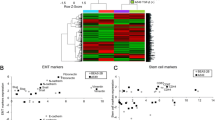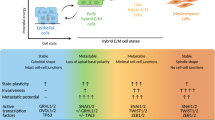Abstract
The epithelial–mesenchymal transition (EMT) has a crucial role in normal and disease processes including tumor progression. In this study, we first classified epithelial-like and mesenchymal-like oral squamous cell carcinoma (OSCC) cell lines based on expression profiles of typical EMT-related genes using a panel of 18 OSCC cell lines. Then, we performed methylation-based and expression-based analyses of components of the Wnt signaling pathway, and identified WNT7A and WNT10A as genes silenced by mesenchymal-specific DNA hypermethylation in OSCCs. A significant association was revealed between some clinicopathological findings and the DNA methylation status of WNT7A (normal vs tumor, P=0.007; T1–2 vs T3–4, P=0.040; I–III vs IV, P=0.016) and WNT10A (N0–N1 vs N2–N3, P=0.046) in the advanced stages of OSCC. Moreover, we found that E-cadherin expression in cancer cells may be positively regulated by WNT7A, whose expression is negatively regulated by mesenchymal-specific DNA hypermethylation or ZEB1 in mesenchymal-like OSCC cells. Our findings indicate that epithelial-specific gene silencing through mesenchymal-specific DNA hypermethylation may stabilize the phenotypic plasticity of cancer cells during EMT/MET.
This is a preview of subscription content, access via your institution
Access options
Subscribe to this journal
Receive 50 print issues and online access
$259.00 per year
only $5.18 per issue
Buy this article
- Purchase on Springer Link
- Instant access to full article PDF
Prices may be subject to local taxes which are calculated during checkout




Similar content being viewed by others
Abbreviations
- EMT:
-
epithelial–mesenchymal transition
- MET:
-
mesenchymal-to-epithelial transition
- OSCC:
-
oral squamous cell carcinoma
- miRNA:
-
microRNA
- 5-aza-dCyd:
-
5-aza 2′-deoxycytidine
- siRNA:
-
small interfering RNA
- rhWNT7A:
-
recombinant human WNT7A
References
Berdasco M, Esteller M . (2010). Aberrant epigenetic landscape in cancer: how cellular identity goes awry. Dev cell 19: 698–711.
Bracken CP, Gregory PA, Kolesnikoff N, Bert AG, Wang J, Shannon MF et al. (2008). A double-negative feedback loop between ZEB1-SIP1 and the microRNA-200 family regulates epithelial-mesenchymal transition. Cancer Res 68: 7846–7854.
Burk U, Schubert J, Wellner U, Schmalhofer O, Vincan E, Spaderna S et al. (2008). A reciprocal repression between ZEB1 and members of the miR-200 family promotes EMT and invasion in cancer cells. EMBO Rep 9: 582–589.
Chuang JC, Jones PA . (2007). Epigenetics and microRNAs. Pediatr Res 61: 24R–29R.
Dumont N, Wilson MB, Crawford YG, Reynolds PA, Sigaroudinia M, Tlsty TD . (2008). Sustained induction of epithelial to mesenchymal transition activates DNA methylation of genes silenced in basal-like breast cancers. Proc Natl Acad Sci USA 105: 14867–14872.
Eger A, Aigner K, Sonderegger S, Dampier B, Oehler S, Schreiber M et al. (2005). DeltaEF1 is a transcriptional repressor of E-cadherin and regulates epithelial plasticity in breast cancer cells. Oncogene 24: 2375–2385.
Furuta M, Kozaki K, Tanaka S, Arii S, Imoto I, Inazawa J . (2009). miR-124 and miR-203 are epigenetically silenced tumor-suppressive microRNAs in hepatocellular carcinoma. Carcinogenesis 31: 766–776.
Greenlee RT, Murray T, Bolden S, Wingo PA . (2000). Cancer statistics, 2000. CA Cancer J Clin 50: 7–33.
Gregory PA, Bert AG, Paterson EL, Barry SC, Tsykin A, Farshid G et al. (2008). The miR-200 family and miR-205 regulate epithelial to mesenchymal transition by targeting ZEB1 and SIP1. Nat Cell Biol 10: 593–601.
Ha PK, Califano JA . (2006). Promoter methylation and inactivation of tumour-suppressor genes in oral squamous-cell carcinoma. Lancet Oncol 7: 77–82.
Herman JG, Baylin SB . (2003). Gene silencing in cancer in association with promoter hypermethylation. N Engl J Med 349: 2042–2054.
Kalluri R, Weinberg RA . (2009). The basics of epithelial-mesenchymal transition. J Clin Invest 119: 1420–1428.
Kozaki K, Imoto I, Mogi S, Omura K, Inazawa J . (2008). Exploration of tumor-suppressive microRNAs silenced by DNA hypermethylation in oral cancer. Cancer Res 68: 2094–2105.
Nomura K, Sobue T, Nakatani H, Maehara M, Kiryu Y, Tsukuma H, et al., The Editorial Board of Cancer Statistics in Japan. (2005). Number of deaths and proportional mortality rates from malignant neoplasms by site in Japan. Cancer Statistics in Japan 2003 (http://ganjoho.jp/public/statistics/backnumber/2010_en.html), pp 36–39.
Li A, Omura N, Hong SM, Vincent A, Walter K, Griffith M et al. (2010). Pancreatic cancers epigenetically silence SIP1 and hypomethylate and overexpress miR-200a/200b in association with elevated circulating miR-200a and miR-200b levels. Cancer Res 70: 5226–5237.
McNeill H, Woodgett JR . (2010). When pathways collide: collaboration and connivance among signalling proteins in development. Nature 11: 404–413.
Moustakas A, Heldin CH . (2007). Signaling networks guiding epithelial-mesenchymal transitions during embryogenesis and cancer progression. Cancer Sci 98: 1512–1520.
Ohira T, Gemmill RM, Ferguson K, Kusy S, Roche J, Brambilla E et al. (2003). WNT7a induces E-cadherin in lung cancer cells. Proc Natl Acad Sci USA 100: 10429–10434.
Ordway JM, Bedell JA, Citek RW, Nunberg A, Garrido A, Kendall R et al. (2006). Comprehensive DNA methylation profiling in a human cancer genome identifies novel epigenetic targets. Carcinogenesis 27: 2409–2423.
Papageorgis P, Lambert AW, Ozturk S, Gao F, Pan H, Manne U et al. (2010). Smad signaling is required to maintain epigenetic silencing during breast cancer progression. Cancer Res 70: 968–978.
Park SM, Gaur AB, Lengyel E, Peter ME . (2008). The miR-200 family determines the epithelial phenotype of cancer cells by targeting the E-cadherin repressors ZEB1 and ZEB2. Genes Dev 22: 894–907.
Parkin DM, Bray F, Ferlay J, Pisani P . (2005). Global cancer statistics, 2002. CA Cancer J Clin 55: 74–108.
Sato N, Fukushima N, Maitra A, Matsubayashi H, Yeo CJ, Cameron JL et al. (2003). Discovery of novel targets for aberrant methylation in pancreatic carcinoma using high-throughput microarrays. Cancer Res 63: 3735–3742.
Scully C, Field JK, Tanzawa H . (2000). Genetic aberrations in oral or head and neck squamous cell carcinoma (SCCHN): 1. Carcinogen metabolism, DNA repair and cell cycle control. Oral Oncol 36: 256–263.
Song Y, Washington MK, Crawford HC . (2010). Loss of FOXA1/2 is essential for the epithelial-to-mesenchymal transition in pancreatic cancer. Cancer Res 70: 2115–2125.
Suzuki E, Imoto I, Pimkhaokham A, Nakagawa T, Kamata N, Kozaki K et al. (2007). PRTFDC1, a possible tumor-suppressor gene, is frequently silenced in oral squamous-cell carcinomas by aberrant promoter hypermethylation. Oncogene 26: 7921–7932.
Taki M, Kamata N, Yokoyama K, Fujimoto R, Tsutsumi S, Nagayama M . (2003). Down-regulation of Wnt-4 and up-regulation of Wnt-5a expression by epithelial-mesenchymal transition in human squamous carcinoma cells. Cancer Sci 94: 593–597.
Thiery JP, Acloque H, Huang RY, Nieto MA . (2009). Epithelial-mesenchymal transitions in development and disease. Cell 139: 871–890.
Winn RA, Marek L, Han SY, Rodriguez K, Rodriguez N, Hammond M et al. (2005). Restoration of Wnt-7a expression reverses non-small cell lung cancer cellular transformation through frizzled-9-mediated growth inhibition and promotion of cell differentiation. J Biol Chem 280: 19625–19634.
Yang J, Weinberg RA . (2008). Epithelial-mesenchymal transition: at the crossroads of development and tumor metastasis. Dev Cell 14: 818–829.
Acknowledgements
We thank Ayako Takahashi and Rumi Mori for technical assistance. This study was supported in part by Grant-in-Aid for Scientific Research (A), (B) and (C), and Scientific Research on Priority Areas and Innovative Areas, and the Global Center of Excellence Program for International Research Center for Molecular Science in Tooth and Bone Diseases from the Ministry of Education, Culture, Sports, Science and Technology, Japan; a Health and Labour Sciences Research Grant by the Ministry of Health, Labour and Welfare, Japan; a grant from Core Research for Evolutional Science and Technology of the Japan Science and Technology Corporation; and a grant from the New Energy and Industrial Technology Development Organization.
Author information
Authors and Affiliations
Corresponding author
Ethics declarations
Competing interests
The authors declare no conflict of interest.
Additional information
Supplementary Information accompanies the paper on the Oncogene website
Supplementary information
Rights and permissions
About this article
Cite this article
Kurasawa, Y., Kozaki, K., Pimkhaokham, A. et al. Stabilization of phenotypic plasticity through mesenchymal-specific DNA hypermethylation in cancer cells. Oncogene 31, 1963–1974 (2012). https://doi.org/10.1038/onc.2011.373
Received:
Revised:
Accepted:
Published:
Issue Date:
DOI: https://doi.org/10.1038/onc.2011.373
Keywords
This article is cited by
-
Inferring interaction type in gene regulatory networks using co-expression data
Algorithms for Molecular Biology (2015)



